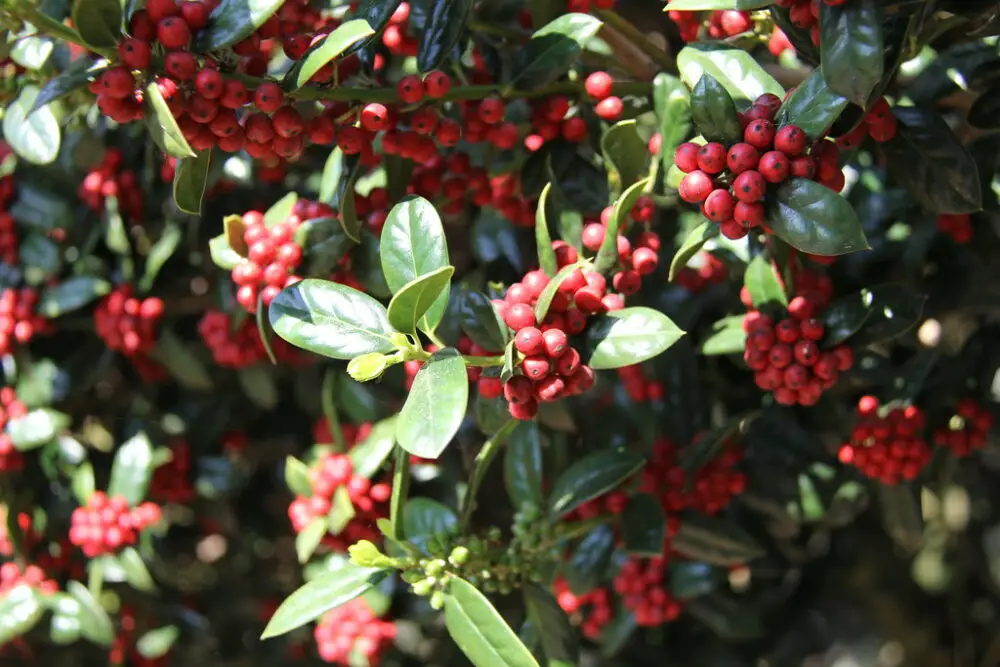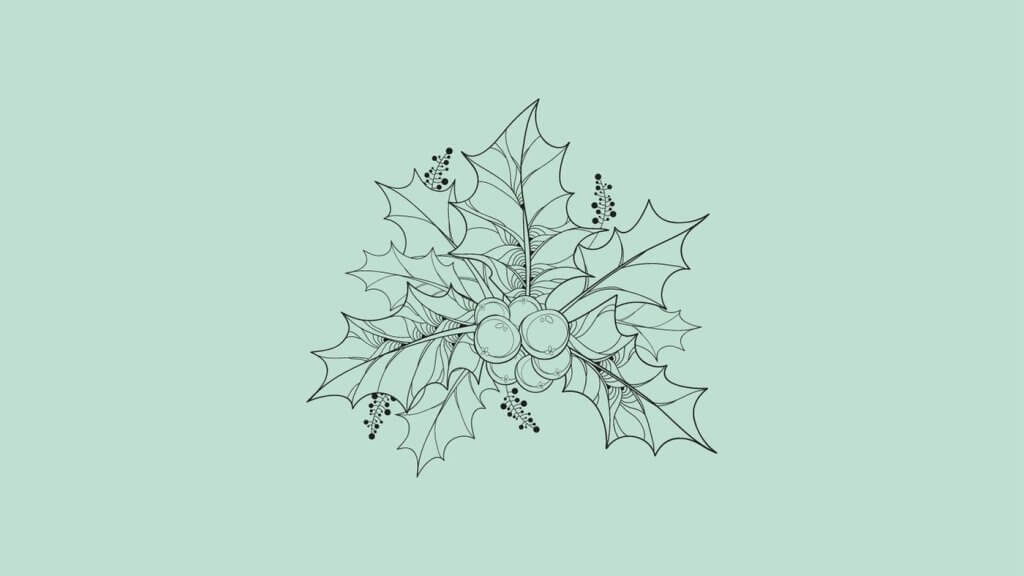Chinese Holly is a densely branched, versatile plant that grows as an evergreen shrub or a small, trimmed tree that can be planted along a drought-tolerant landscape. Chinese holly leaves, berries and plant parts should not be eaten.
Chinese holly: plant profile
Scientific name: Ilex cornuta
Family type: Aquifoliaceae plant family
Plant type: shrubs
What Are You Foraging For Right Now?
We're thrilled to hear your ideas. What would you like to submit today? Feel free to share your thoughts and experiences with us.
Common names:
- Chinese holly
- Horned holly
Ilex cornuta cultivars
A native of eastern China and Korea, Ilex cornuta is valued in horticulture for its large red berries and spiny leaves.
In the horticultural trade, several cultivars and hybrids have been introduced, such as:
- Burfordii (compact and free-fruiting)
- Dazzler (large fruits)
- Needlepoint (bright scarlet fruit)
- Dwarf Burfordi or dwarf burford (particularly compact)
- Nellie R. Stevens (a hybrid with I. aquifolium, very free-fruiting)
How to identify Chinese holly?
Ilex cornuta is a broadleaf evergreen shrub that grows to a height of 2.5 meters or 8 feet. According to records, it can reach a height of 7.6 meters or 25 ft. Each rectangular leaf has four to five spines along its margin. The glossy, leathery dark green leaves are simple and alternate on the stem.
There is a smooth, light gray color to the bark, and as the bark grows, it becomes finely flaky. According to the season, the stem of Ilex cornuta is either green or reddish-purple, and in winter, the green stems turn slightly red.

The flowers found on the shrub are dioecious, so they can be either female or male. As male and female flowers aren’t found on the same plant, the plant can’t reproduce itself; it needs a male and female plant to reproduce.
Bloom time occurs during the spring, and the flowers are dull white with a faint scent.
Red berries are produced by the flowers in early fall, which are noticeably larger than those of the European holly.
Is Chinese holly poisonous?
Chinese holly leaves, branches, and berries are known worldwide to make beautiful holiday decorations, but one must be careful as the berries are considered poisonous to people and pets.
The berries can be slightly toxic to humans if eaten in large quantities. Holly berries can cause vomiting, diarrhea, dehydration, and drowsiness if swallowed.
It is possible that ingesting its berries, which contain a caffeine-like alkaloid, could cause irritation, but a fatal reaction is unlikely.
Are any parts of the plant edible?
There isn’t enough reliable information to know if Chinese holly leaves are safe to eat.
Like the berries, they can also cause side effects such as nausea, diarrhea, vomiting, and stomach and intestinal problems.
Swallowing holly leaf spines could puncture or tear the inside of the mouth and other parts of the digestive tract.
Like some other hollies, Chinese holly leaves and plant parts should not be eaten.

Chinese holly uses
The Chinese have many herbal applications for this holly. Women supposedly use the tea as a contraceptive.
In traditional Chinese medicine, Chinese holly is also used to alleviate several health issues, including:
- Headache
- Toothache
- Rheumatism
- Conjunctivitis
Chinese holly has many design feature uses, too, such as:
- Barrier
- Hedge
- Foundation planting
- Small groups
- Screen/privacy
- Small tree
- Specimen
Where does Chinese holly grow?
Chinese hollies are commonly found throughout the southeast United States as hedge plants. The berries have been scattered by birds and wildlife, and therefore, it can now be found in nature though it was first brought over from China.
The Chinese holly and its cultivars grow in full sun, partial shade, or shade and tolerate a wide range of soils.
Due to its drought resistance and heat tolerance, this plant grows so well, it is considered invasive in some areas, including:
- Kentucky
- North Carolina
- Georgia
- Alabama
- Mississippi
How tall does a Chinese Holly get?
An upright, bushy evergreen shrub with a well-branched structure, the Chinese holly maintains leaves close to the ground and grows into a compact, symmetrical bush.
As it grows 6 inches per year, within 10 years, it will be about 6 feet tall, and when mature, it will be 8 to 10 feet tall and 6 to 8 feet wide.
How do you grow Chinese holly?
Picking
Late autumn is the best time to harvest holly berries, usually in November or December.
Trees sometimes retain their fruit throughout the winter, so they can be picked by hand as late as April.
Extraction and storage
The berries should be separated from twigs. Store them in a cool, dry place in buckets.
Pretreatment
Add equal parts of horticultural sand or a sand/compost mixture to the seeds. You can use 50% leafmould and 50% horticultural sand. Add two or three handfuls of the mixture to each handful of seeds.
Put a layer of stones at the bottom of a pot big enough to hold the seed/sand mixture (and a bit more). The stones should be covered with sand. Add the seed/sand mixture over this and cover it with 2-3 cm or about 1 inch of sand.
It takes a full summer (warm temperatures) for the hard outer seedcoat of Chinese holly seeds to break down, allowing oxygen and water to reach the embryonic trees.
Sowing
When the seeds have spent the summer and winter outside, they are ready to be sown in pots about 8cm in diameter.
Plant each seed as it begins to germinate, one per pot. Firmly cover the seed with compost.
Watering
Water and feed the pots regularly.
Growing
Your seedlings will reach a height of 20cm or 8 inches during the first year in pots.
This first year, transplant the young trees into 1- or 2-liter pots in the fall, taking care not to disturb the roots too much.
By the second year, they will be large enough for planting out if they are well fed.
Ilex Cornuta Plant Care Tips
- Make sure your Chinese holly is planted in moist soil with good drainage.
- To conserve moisture, use shredded or chipped mulch.
- The plant does well in full or partial sun but also tolerates part shade and full shade. In colder regions, try planting in a sheltered area away from drying winter wind. Chinese holly grows best in climates found in USDA plant hardiness zones 7 through 9.
- Plant when it’s cool out. Generally, late fall, early winter, or early spring are the best times.
- Care for this holly doesn’t take much time or effort. In dry periods, the plants need a deep drink.
- Plants should be fed a slow-release shrub and tree fertilizer once a year during late winter or early spring. The sulfur and/or iron in the fertilizer will promote constant greening.
Ana has always been interested in all things nature and flora. With her expertise in home gardening and interest in foraging, she has been spending her weekends and free time looking for edible native plants, flowers, and fungi. One of her many hobbies includes testing new savory and sweet recipes, juices or teas made from freshly picked plants, wild fruits, or mushrooms.

